The Effect of Drip Irrigation and Nitrogen Levels on the Oil and Fatty Acid Composition of Sesame and Its Economic Analysis
Abstract
1. Introduction
2. Materials and Methods
2.1. Study Area
2.2. Climate
2.3. Field Experiment
2.4. Irrigation System and Treatments
2.5. Calculation of Evapotranspiration
2.6. Determination of Water and Irrigation Water Use Efficiency
2.7. Crop Water Productivity
2.8. Economic Water Productivity (EWP)
2.9. Crude Oil and Fatty Acid Composition
2.10. Statistical Analysis
3. Results
3.1. Water Use Efficiency and Economic Analysis
3.2. Fat Ratio and Fatty Acid Properties
4. Discussion
4.1. Effect of Irrigation on Sesame Yield
4.2. Impact of Fertilisation
5. Conclusions
Author Contributions
Funding
Data Availability Statement
Conflicts of Interest
References
- Kaplan, M.; Kara, K.; Unlukara, A.; Kale, H.; Buyukkilic Beyzi, S.; Varol, I.S.; Kizilsimsek, M. Water deficit and nitrogen affects yield and feed value of sorghum sudangrass silage. Agric. Water Manag. 2019, 218, 30–36. [Google Scholar] [CrossRef]
- Rolbiecki, S.; Rolbiecki, R.; Jagosz, B.; Kasperska-Wołowicz, W.; Kanecka-Geszke, E.; Stachowski, P.; Kocięcka, J.; Bąk, B. Water Needs of Sweet Cherry Trees in the Light of Predicted Climate Warming in the Bydgoszcz Region, Poland. Atmosphere 2023, 14, 511. [Google Scholar] [CrossRef]
- Ewaid, S.H.; Abed, S.A.; Al-Ansari, N. Crop Water Requirements and Irrigation Schedules for Some Major Crops in Southern Iraq. Water 2019, 11, 756. [Google Scholar] [CrossRef]
- Ucar, Y.; Kocięcka, J.; Liberacki, D.; Rolbiecki, R. Analysis of Crop Water Requirements for Apple Using Dependable Rainfall. Atmosphere 2023, 14, 99. [Google Scholar] [CrossRef]
- Akcura, S.; Tas, I.; Kokten, K.; Kaplan, M.; Bengu, A.S. Effects of irrigation intervals and irrigation levels on oil content and fatty acid composition of peanut cultivars. Not. Bot. Horti Agrobot. Cluj-Napoca 2021, 49, 12224. [Google Scholar] [CrossRef]
- Kale Celik, S. Deficit irrigation under water stress and salinity conditions: Fao-aquacrop model. Infrastruct. Ecol. Rural Areas 2022, 17, 96–106. [Google Scholar]
- Ertop, H.; Kocięcka, J.; Atilgan, A.; Liberacki, D.; Niemiec, M.; Rolbiecki, R. The Importance of Rainwater Harvesting and Its Usage Possibilities: Antalya Example (Turkey). Water 2023, 15, 2194. [Google Scholar] [CrossRef]
- Kaplan, M.; Kokten, K.; Uzun, S. Fatty acid and metal composition of the seeds of Vicia ervilia varieties from Turkey. Chem. Nat. Compd. 2014, 50, 117–119. [Google Scholar] [CrossRef]
- Vyas, S.P.; Kathju, S.; Garg, B.K.; Lahiri, A.N. Influence of supplemental irrigation and urea application on the productivity and nitrogen metabolism of sesame. Indian J. Plant Physiol. 1999, 4, 197–201. [Google Scholar]
- Zenawi, G.; Mizan, A. Effect of Nitrogen Fertilization on the Growth and Seed Yield of Sesame (Sesamum indicum L.). Int. J. Agron. 2019, 2019, 5027254. [Google Scholar] [CrossRef]
- Golan, E.; Peleg, Z.; Tietel, Z.; Erel, R. Sesame response to nitrogen management under contrasting water availabilities. Oil Crop Sci. 2022, 7, 166–173. [Google Scholar] [CrossRef]
- Langham, D.R.; Riney, J.; Smith, G.; Wiemers, T. Sesame grower guide. Sesaco Corp. 2008, 30, 331. Available online: https://baylor.agrilife.org/files/2011/05/sesamegrowerguide2008.pdf (accessed on 15 March 2022).
- Tan, A.Ș. Yield potential of some sesame cultivars in Menemen conditions. Anadolu Ege Tarımsal Araştırma Enst. Derg. 2011, 21, 11–28. [Google Scholar]
- Betram, K.; Janssens, M.J.J.; Abdalwahab, A. Breeding for drought tolerance in sesame (Sesamum indicum). In Proceedings of the Conference on Technological and Institutional Innovations for Sustainable Rural Development, Deutscher Tropentag, Göttingen, Germany, 8–10 October 2003; Volume 810, p. 135. [Google Scholar]
- Arslan, H.; Hatipoğlu, H.; Karakuş, M. Determination of Yield and Yield Components as a Second Crop of Some Sesame Genotypes Collected from Sanliurfa Region. Turk. J. Agric. Res. 2014, 1, 109–116. [Google Scholar] [CrossRef]
- Yoshida, H.; Takagi, S. Effects of seed roasting temperature and time on the quality characteristics of sesame (Sesamum indicum) oil. J. Sci. Food Agric. 1997, 75, 19–26. [Google Scholar] [CrossRef]
- Brouwer, C.; Heibloem, M. Irrigation water management: Irrigation water needs. Train. Man. 1986, 3, 1–5. [Google Scholar]
- Eylen, M.; Kanber, R.; Tok, A. Çukurova Koşullarında Karık ve Damla Sulama Yöntemleri İle Sulanan Çileğin Verim ve Su Tüketimi. In Köy Hizmetleri Araştırma Enstitüsü Yayınları; Tarsus: Mersin, Turkey, 1986; p. 39. [Google Scholar]
- James, L.G. Principles of Farm Irrigation System Design; Krieger Puplishing Company: Malabar, FL, USA, 1993; p. 544. [Google Scholar]
- Maximov, N.A. The Plant in Relation to Water; George Ailen & Unwin: London, UK, 1929. [Google Scholar]
- Viets, F.G. Fertilizers and the efficient use of water. Adv. Agron. 1962, 14, 223–264. [Google Scholar] [CrossRef]
- Howell, T.A.; Cuenca, R.H.; Solomon, K.H. Crop Yield Response. In Management of Farm Irrigation Systems; Hoffman, G.J., Howell, T.A., Solomon, K.H., Eds.; American Society of Agricultural Engineers: St. Joseph, MI, USA, 1990; pp. 93–122. [Google Scholar]
- Boutraa, T. Improvement of water use efficiency in irrigated agriculture: A review. J. Agron. 2010, 9, 1–8. [Google Scholar] [CrossRef]
- Boyacı, S.; Kocięcka, J.; Atilgan, A.; Niemiec, M.; Liberacki, D.; Rolbiecki, R. Determination of the Effects of Different Irrigation Levels and Vermicompost Doses on Water Consumption and Yield of Greenhouse-Grown Tomato. Water 2024, 16, 1095. [Google Scholar] [CrossRef]
- Guo, D.; Olesen, J.E.; Manevski, K.; Ma, X. Optimizing irrigation schedule in a large agricultural region under different hydrologic scenarios. Agric. Water Manag. 2021, 245, 106575. [Google Scholar] [CrossRef]
- Ucak, A.B.; Kocięcka, J.; Liberacki, D.; Saltuk, B.; Atilgan, A.; Stachowski, P.; Rolbiecki, R. The effects of high temperature and low humidity on crop water stress index of seed pumpkin plants (Cucurbita pepo L.) in semi-arid climate conditions. Acta Sci. Pol. Hortorum Cultus 2024, 23, 63–73. [Google Scholar] [CrossRef]
- French, R.J.; Schultz, J.E. Water use efficiency of wheat in a Mediterranean-type environment. I. The relation between yield, water use and climate. Aust. J. Agric. Res. 1984, 35, 743–764. [Google Scholar] [CrossRef]
- Bessembinder, J.J.E.; Leffelaar, P.A.; Dhindwal, A.S.; Ponsioen, T.C. Which crop and which drop, and the scope for improvement of water productivity. Agric. Water Manag. 2005, 73, 113–130. [Google Scholar] [CrossRef]
- Passioura, J. Increasing crop productivity when water is scarce-from breeding to field management. Agric. Water Manag. 2006, 80, 176–196. [Google Scholar] [CrossRef]
- Tewelde, A.G. Evaluating the Economic Water Productivity underfull and deficit irrigation; The case of sesamecrop (Sesumum indicum L.) in woreda Kafta-Humera, Tigrai-Ethiopia. Water Sci. 2019, 33, 75–83. [Google Scholar] [CrossRef]
- Bligh, E.G.; Dyer, W.J. A Rapid Method of Total Lipid Extraction and Purification. Can. J. Biochem. Physiol. 1959, 37, 911–917. [Google Scholar] [CrossRef]
- Ackman, R.G. Remarks on official methods employing boron trifluoride in the preparation of methyl esters of the fatty acids of fish oils. J. Am. Oil Chem. Soc. 1998, 75, 541–545. [Google Scholar] [CrossRef]
- Bannon, C.D.; Craske, J.D.; Hai, N.T.; Harper, N.L.; O’Rourke, K.L. Analysis of fatty acid methyl esters with high accuracy and reliability: II. Methylation of fats and oils with boron trifluoride-methanol. J. Chromatogr. A 1982, 247, 63–69. [Google Scholar] [CrossRef]
- Tas, I. Evaluation of Irrigation Experiments with GGE Biplot Method and Economic Analysis of Drip Irrigation System: A Case Study of Peanut Production. J. Agric. Sci. 2023, 29, 464–477. [Google Scholar] [CrossRef]
- Dervis, O. Çukurova koşullarinda buğdaydan sonra ikinci ürün susamin su tüketimi In Köy Hizmetleri Araştırma Enstitüsü Yayınları; Tarsus: Mersin, Turkey, 1986; p. 53. [Google Scholar]
- Bastug, R.; Karaca, C.; Buyuktas, D.; Aydinsakir, K.; Dinc, N. The effects of deficit irrigation practices on evapotranspiration, yield and quality characteristics of two sesame varieties (Sesamum indicum L.) grown in lysimeters under the Mediterranean climate conditions. Irrig. Sci. 2021, 39, 587–606. [Google Scholar] [CrossRef]
- El Naim, A.M.; Ahmed, M.F. Effect of irrigation on vegetative growth, oil yield and protein content of two sesame (Sesamum indicum L.) cultivars. Res. J. Agric. Biol. Sci. 2010, 6, 630–636. [Google Scholar]
- Kassab, O.M.; El-Noemani, A.A.; El-Zeiny, H.A. Influence of some irrigation systems and water regimes on growth and yield of sesame plants. J. Agron. 2005, 4, 220–224. [Google Scholar] [CrossRef]
- Sepaskhah, A.R.; Andam, M. Crop coefficient of sesame in a semi-arid region of IR Iran. Agric. Water Manag. 2001, 49, 51–63. [Google Scholar] [CrossRef]
- Ucan, K.; Kıllı, F.; Gençoğlan, C.; Merdun, H. Effect of irrigation frequency and amount on water use efficiency and yield of sesame (Sesamum indicum L.) under field conditions. Field Crops Res. 2007, 101, 249–258. [Google Scholar] [CrossRef]
- Tantawy, M.M.; Ouda, S.A.; Khalil, F.A. Irrigation optimization for different sesame varieties grown under water stress conditions. J. App. Sci. Res 2007, 3, 7–12. [Google Scholar]
- Hassanzadeh, M.; Ebadi, A.; Panahyan-e-Kivi, M.; Eshghi, A.G.; Jamaati-e-Somarin, S.; Saeidi, M.; Zabihi-e-Mahmoodabad, R. Evaluation of drought stress on relative water content and chlorophyll content of sesame (Sesamum indicum L.) genotypes at early flowering stage. Res. J. Environ. Sci. 2009, 3, 345–350. [Google Scholar] [CrossRef]
- Eskandari, H.; Zehtab-Salmasi, S.; Ghassemi-Golezani, K.; Gharineh, M.H. Effects of water limitation on grain and oil yields of sesame cultivars. J. Food Agric. Environ. 2009, 7, 339–342. [Google Scholar]
- Loggale, L.B. Performance of two sesame cultivars as influenced by supplemental irrigation at Abu Naama. IOSR J. Agric. Vet. Sci. 2018, 11, 6–11. [Google Scholar]
- Balasubramanian, V.; Alves, B.; Aulakh, M.; Bekunda, M.; Cai, Z.; Drinkwater, L.; Mugendi, D.; Kessel, C.V.; Oenema, O. Crop, environmental, and management factors affecting nitrogen use efficiency. In Agriculture and the Nitrogen Cycle; SCOPE Series, 65; Mosier, A.R., Syers, J.K., Freney, J., Eds.; Island Press: Washington, DC, USA, 2004; pp. 19–33. [Google Scholar]
- Ogundare, S.K.; Oloniruha, J.A.; Ayodele, F.G.; Bello, I.A. Effect of different spacing and urea application rates on fruit nutrient composition, growth and yield of tomato in derived savannah vegetation of Kogi state, Nigeria. Am. J. Plant Sci. 2015, 6, 2227. [Google Scholar] [CrossRef]
- Babajide, P.A.; Oyeleke, O.R. Evaluation of sesame (Sesamum indicum L.) for optimum nitrogen requirement under usual farmers’ practice of basal organic manuring in the Savanna ecoregion of Nigeria. J. Nat. Sci. Res. 2014, 4, 17. [Google Scholar]
- Wei, S.; Li, C.; Gao, T.; Li, F.; Haiyang, Z. Effects of nitrogen, phosphorus and potassium fertilizers in sesame. J. Plant Nutr. Fertil. 2013, 3, 15. [Google Scholar]
- Motaka, G.; Paramar, D.; Patel, J. Response of sesame (Sesamum indicum L.) to organic and inorganic sources of nitrogen in light textured soils of semi arid Bhal region. Bioscan 2016, 11, 1653–1658. [Google Scholar]
- El-Sherif, A. Sesame (Sesamum indicum L.) yield and yield components influenced by nitrogen and foliar micronutrient applications in the Fayoum region, Egypt. Egypt. J. Agron. 2016, 38, 355–367. [Google Scholar] [CrossRef]
- Bahar, A.H.; Ismail, M.A.; Sulaiman, A.S.H.; Ali, S.A.M. Response of sesame (Sesamum indicum L) to nitrogen fertilization and plant density under rain fed at Zalingei area. ARPN J. Sci. Technol. 2018, 5, 291–294. [Google Scholar]
- El Tinay, A.H.; Khattab, A.H.; Khidir, M.O. Protein and oil composition of the sesame seed. J. Am. Oil Chem. Soc. 1976, 53, 648–653. [Google Scholar] [CrossRef]
- Kim, K.; Ryu, S.; Chung, H. Influence of drought stress on chemical composition of sesame seed. Korean J. Crop Sci. 2006, 51, 73–80. [Google Scholar]
- Were, B.A.; Onkware, A.O.; Gudu, S.; Welander, M.; Carlsson, A.S. Seed oil content and fatty acid composition in East African sesame (Sesamum indicum L.) accessions evaluated over 3 years. Field Crops Res. 2006, 97, 254–260. [Google Scholar] [CrossRef]
- Elleuch, M.; Besbes, S.; Roiseux, O.; Blecker, C.; Attia, H. Quality characteristics of sesame seeds and by-products. Food Chem. 2007, 103, 641–650. [Google Scholar] [CrossRef]
- Unal, M.K.; Yalcin, H. Proximate composition of Turkish sesame seeds and characterization of their oils. Grasas Aceites 2008, 59, 23–26. [Google Scholar] [CrossRef]
- Kadkhodaie, A.; Razmjoo, J.; Zahedi, M.; Pessarakli, M. Oil content and composition of sesame (Sesamum indicum L.) genotypes as affected by irrigation regimes. J. Am. Oil Chem. Soc. 2014, 91, 1737–1744. [Google Scholar] [CrossRef]
- Ozkan, A.; Kulak, M. Effects of water stress on growth, oil yield, fatty acid composition and mineral content of sesamum indicum. J. Anim. Plant Sci. 2013, 23, 1686–1690. [Google Scholar]
- Zarei, G.; Shamsi, H.; Dehghani, S.M. The effect of drought stress on yield, yield components and seed oil content of three autumnal rapeseed cultivars (Brassica napus L.). J. Res. Agric. Sci. 2010, 6, 29–37. [Google Scholar]
- Al-Barrak, K.M. Irrigation interval and nitrogen level effects on growth and yield of canola (Brassica napus L.). Sci. J. King Faisal Univ. 2006, 7, 87–103. [Google Scholar]
- Alpaslan, M.; Boydak, E.; Hayta, M.; Gercek, S.; Simsek, M. Effect of row space and irrigation on seed composition of Turkish sesame (Sesamum indicum L.). J. Am. Oil Chem. Soc. 2001, 78, 933–935. [Google Scholar] [CrossRef]
- Laribi, B.; Bettaieb, I.; Kouki, K.; Sahli, A.; Mougou, A.; Marzouk, B. Water deficit effects on caraway (Carum carvi L.) growth, essential oil and fatty acid composition. Ind. Crops Prod. 2009, 30, 372–379. [Google Scholar] [CrossRef]
- Hamrouni, I.; Salah, H.B.; Marzouk, B. Effects of water-deficit on lipids of safflower aerial parts. Phytochemistry 2001, 58, 277–280. [Google Scholar] [CrossRef]
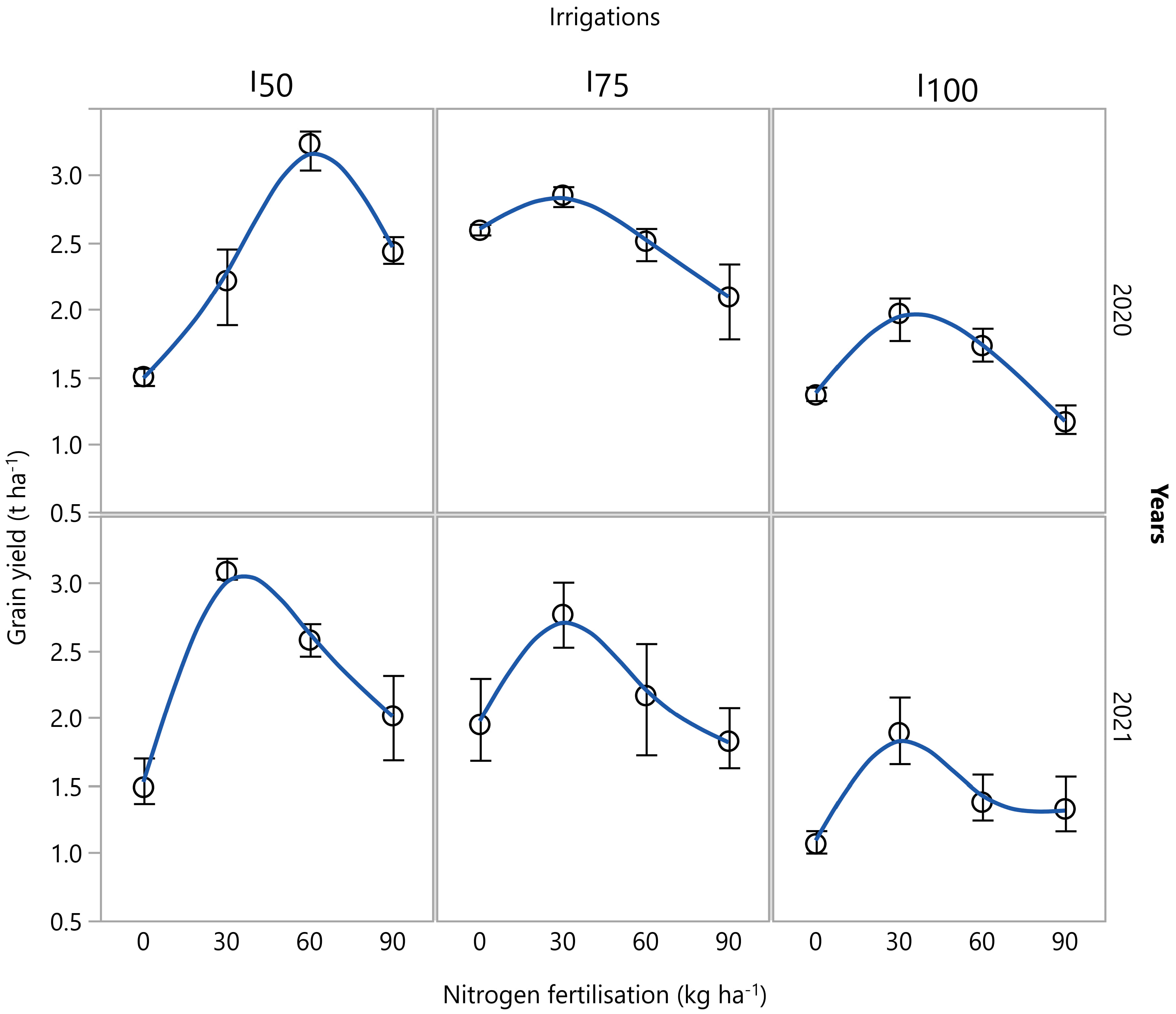
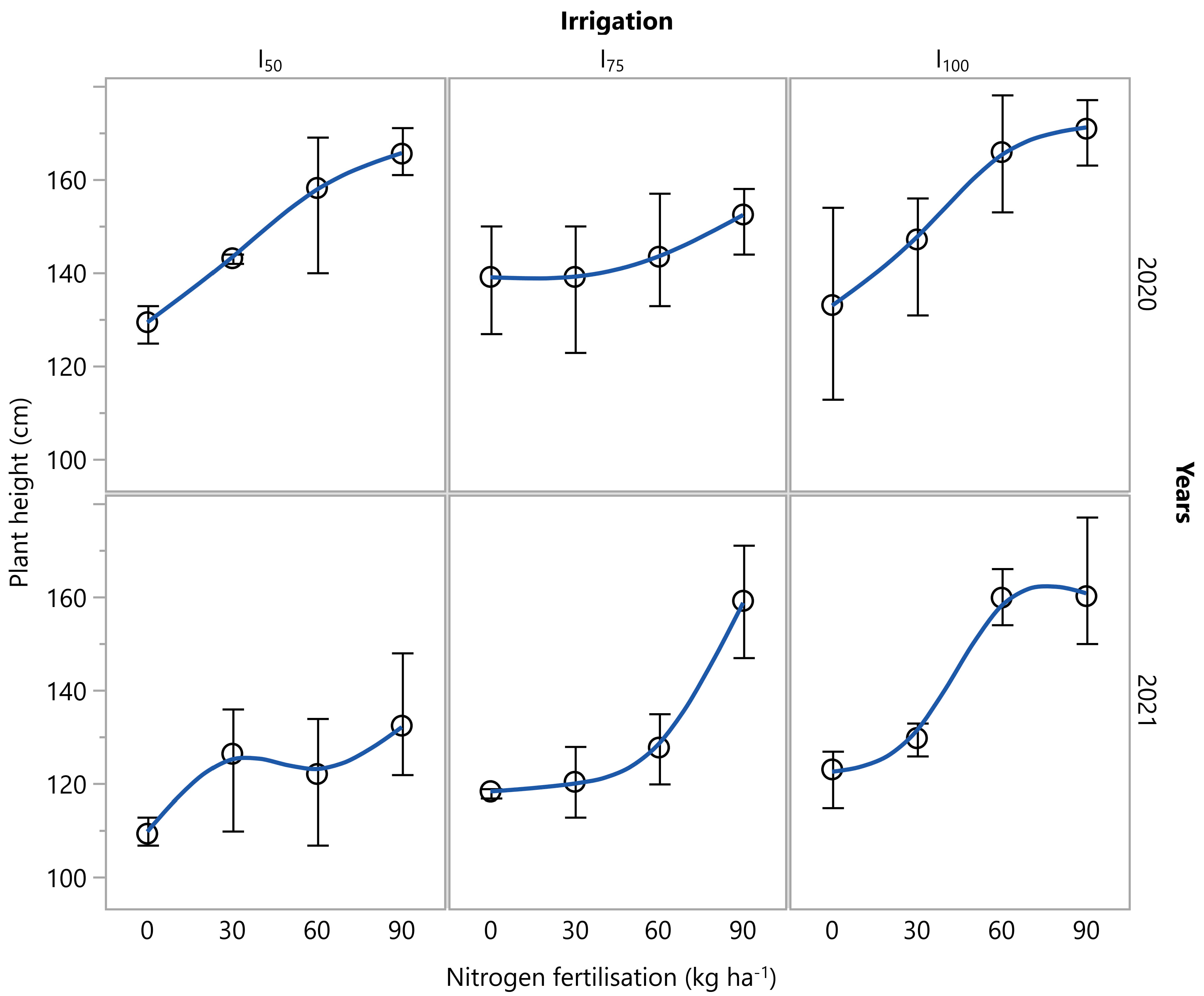
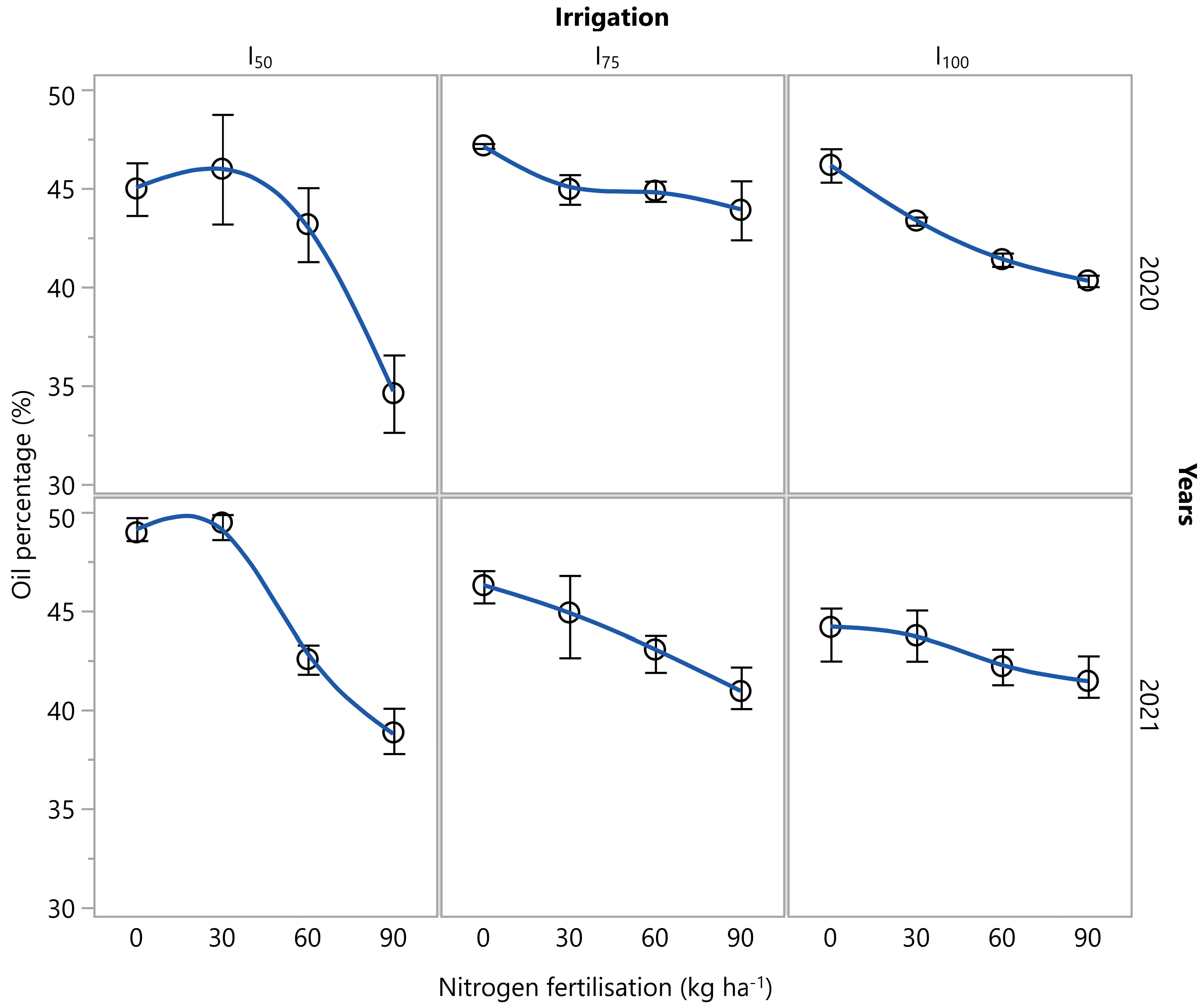
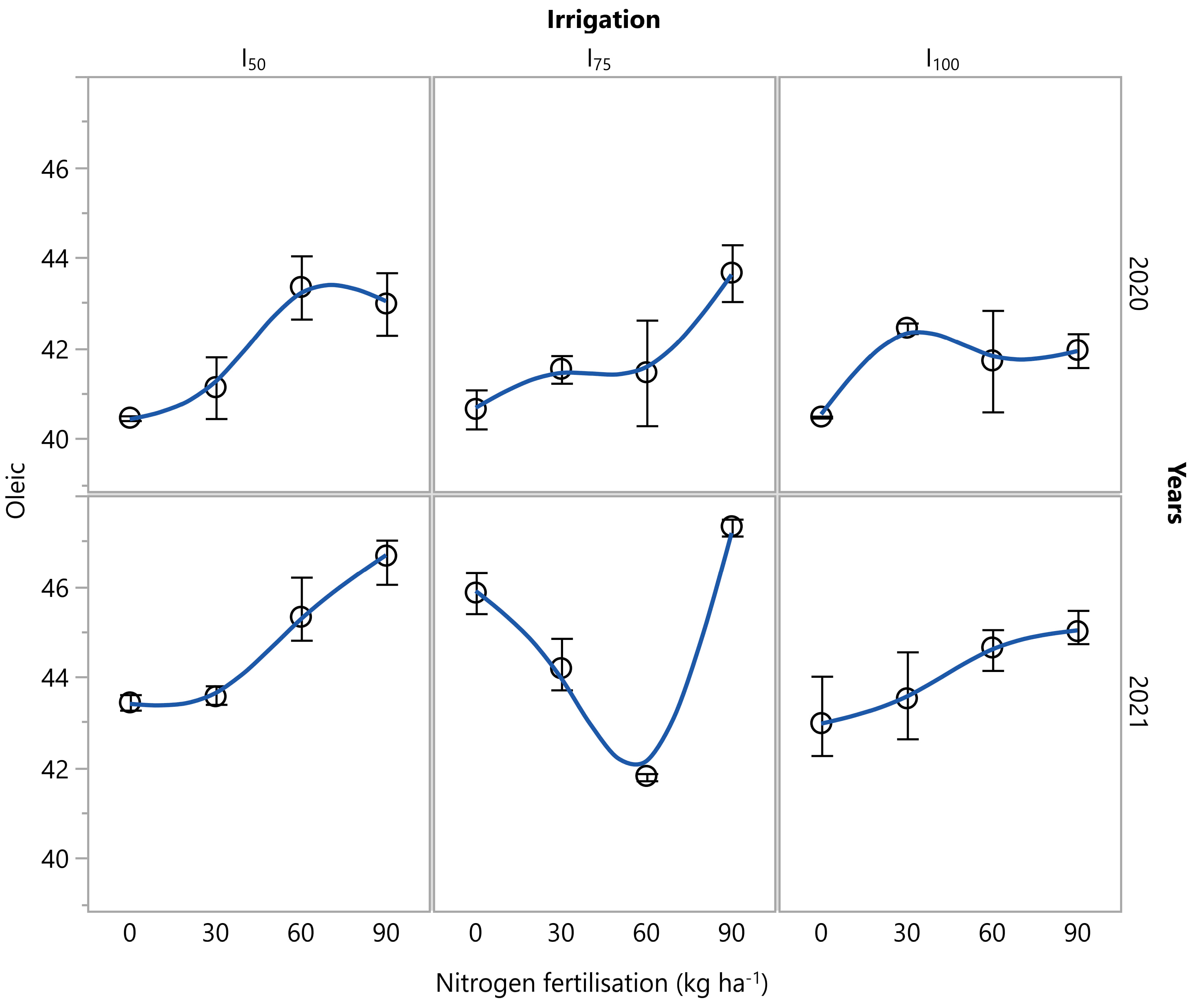
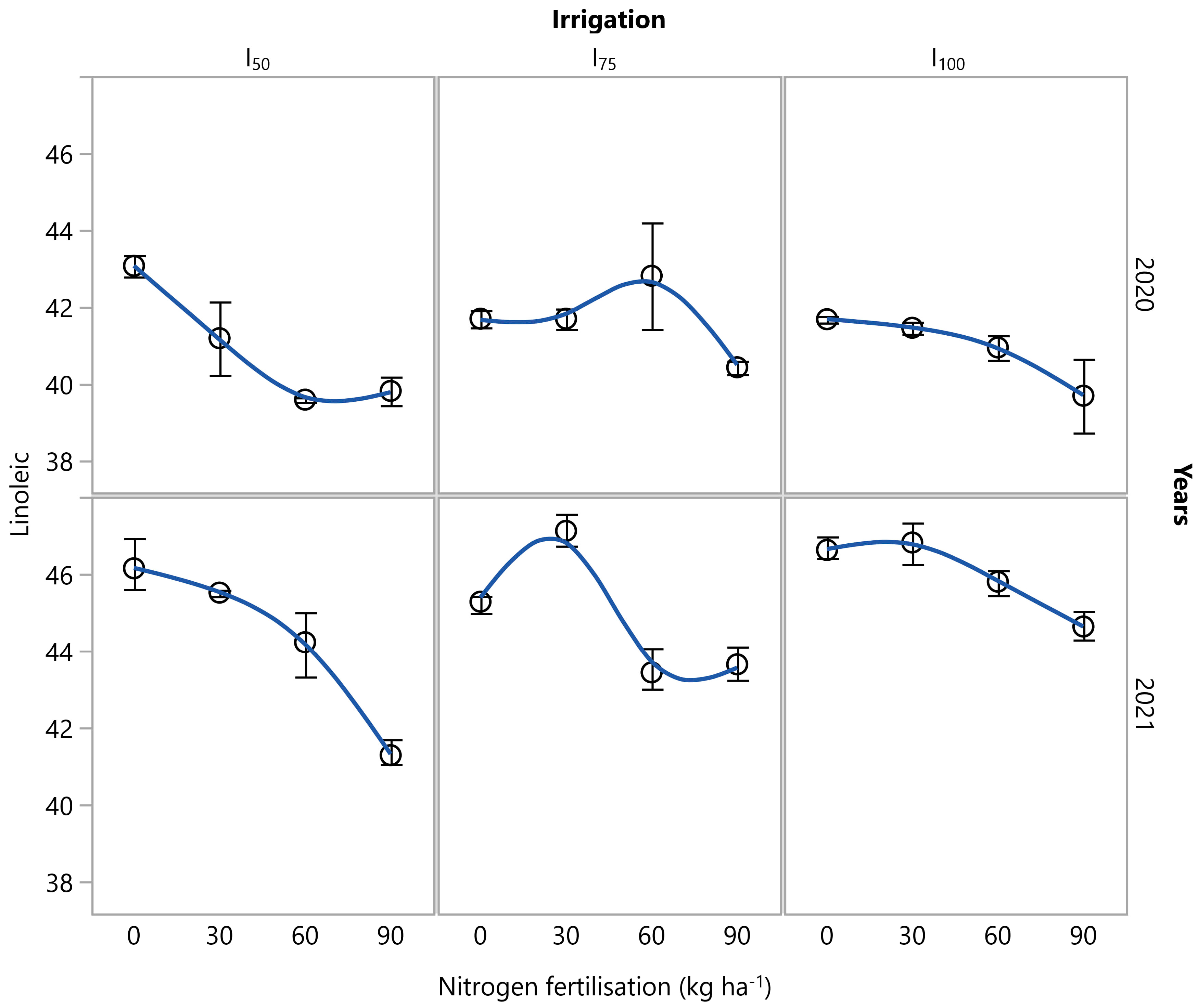
| Depth (cm) | 0–30 | 30–60 | 60–90 |
|---|---|---|---|
| Texture | Clay-Loam | Clay-Loam | Sand-Clay-Loam |
| Saturation (%) | 48.93 | 59.40 | 40.30 |
| pH | 7.78 | 8.08 | 8.11 |
| EC (dS·m−1) | 0.48 | 0.44 | 0.85 |
| Lime (%) | 12.01 | 18.10 | 14.80 |
| Organic matter (%) | 1.49 | 1.74 | 1.91 |
| Phosphorus (kg P2O5·ha−1) | 470.58 | 390.63 | 380.62 |
| Potassium (kg K2O·ha−1) | 620.17 | 860.48 | 300.23 |
| FC (%) | 32.80 | 36.20 | 35.10 |
| PWP (%) | 19.80 | 22.60 | 22.50 |
| BD (g·cm−3) | 1.43 | 1.39 | 1.46 |
| Months | Temperature (°C) | Relative Humidity RH (%) | Wind Speed R (m·s−1) | Rainfall (mm) | Evaporation (mm) | ||
|---|---|---|---|---|---|---|---|
| Mean | Max | Min | |||||
| January | 6.3 | 9.7 | 3.2 | 80.0 | 4.5 | 93.7 | - * |
| February | 6.7 | 10.3 | 3.5 | 78.5 | 4.7 | 71.7 | - * |
| March | 8.3 | 12.4 | 4.8 | 77.0 | 4.3 | 68.3 | - * |
| April | 12.6 | 17.2 | 8.5 | 75.0 | 3.8 | 47.0 | 110.0 |
| May | 17.6 | 22.6 | 12.8 | 73.2 | 3.4 | 32.0 | 168.3 |
| June | 22.3 | 27.8 | 16.7 | 67.6 | 3.3 | 22.4 | 217.0 |
| July | 25.1 | 30.7 | 19.4 | 62.9 | 3.8 | 11.7 | 268.3 |
| August | 25.0 | 30.6 | 19.6 | 63.3 | 4.0 | 6.5 | 252.2 |
| September | 20.9 | 26.4 | 15.9 | 68.0 | 3.7 | 24.2 | 170.8 |
| October | 16.0 | 20.7 | 12.1 | 74.3 | 3.7 | 57.0 | 103.5 |
| November | 11.9 | 15.9 | 8.4 | 78.7 | 3.9 | 86.1 | - * |
| December | 8.5 | 11.8 | 5.4 | 80.3 | 4.4 | 108.2 | - * |
| Aver/Total | 15.1 | 19.7 | 10.9 | 73.2 | 4.0 | 628.8 | 1290.1 |
| Months | Temperature (°C) | Relative Humidity RH (%) | Wind Speed R (m·s−1) | Rainfall (mm) | Evaporation (mm) | ||
|---|---|---|---|---|---|---|---|
| Mean | Max | Min | |||||
| 2020 | |||||||
| January | 7.3 | 11.5 | 4.3 | 67.6 | 3.7 | 57.2 | 39.5 |
| February | 9.7 | 14.0 | 6.0 | 69.3 | 4.1 | 48.0 | 37.3 |
| March | 11.7 | 16.1 | 8.1 | 68.6 | 3.6 | 24.3 | 61.6 |
| April | 12.3 | 17.7 | 8.0 | 68.2 | 3.7 | 55.7 | 119.5 |
| May | 18.2 | 23.6 | 13.5 | 68.9 | 3.0 | 54.6 | 151.9 |
| June | 22.6 | 28.4 | 17.8 | 74.0 | 3.0 | 38.8 | 213.7 |
| July | 27.0 | 32.9 | 21.7 | 55.3 | 4.1 | 0.1 | 341.2 |
| August | 27.1 | 33.4 | 21.6 | 54.2 | 3.5 | 3.2 | 300.1 |
| September | 24.7 | 29.7 | 20.6 | 59.6 | 3.5 | 9.5 | 229.9 |
| October | 19.3 | 24.7 | 14.8 | 77.5 | 4.0 | 51.3 | 129.6 |
| November | 12.7 | 17.0 | 9.2 | 79.4 | 2.5 | 0.7 | 96.9 |
| December | 11.5 | 14.4 | 9.2 | 87.3 | 3.4 | 113.8 | 47.4 |
| Avg/Total | 17 | 22 | 13 | 69 | 4 | 457 | 1769 |
| 2021 | |||||||
| January | 9.8 | 13.2 | 6.8 | 74.8 | 5.0 | 165.3 | 91.2 |
| February | 9.1 | 13.4 | 5.8 | 75.8 | 4.7 | 124.7 | 68.5 |
| March | 9.2 | 14.0 | 5.1 | 79.1 | 3.0 | 74.0 | 50.6 |
| April | 13.1 | 18.2 | 9.0 | 88.6 | 3.1 | 40.4 | 95.4 |
| May | 19.9 | 25.2 | 16.0 | 66.6 | 3.1 | 57.3 | 181.7 |
| June | 24.1 | 29.3 | 19.5 | 58.3 | 2.0 | 57.1 | 193.0 |
| July | 28.2 | 33.8 | 23.5 | 52.0 | 2.7 | 2.0 | 314.5 |
| August | 28.3 | 33.4 | 24.1 | 51.1 | 2.3 | 0.0 | 289.8 |
| September | 23.1 | 27.6 | 19.1 | 54.0 | 2.7 | 8.9 | 233.7 |
| October | 18.1 | 21.5 | 15.4 | 64.8 | 2.7 | 75.9 | 119.6 |
| November | 15.8 | 19.1 | 13.0 | 68.2 | 3.3 | 26.7 | 77.3 |
| December | 12.2 | 14.8 | 9.8 | 68.7 | 4.2 | 121.0 | 55.7 |
| Avg/Total | 18 | 22 | 14 | 67 | 3 | 753 | 1771 |
| Year | Nitrogen Dose (kg ha−1) | Irrigation Water Level | Irrigation Water (mm) | ETa (mm) | IWUE (kg ha−1 m−3) | WUE (kg ha−1 m−3) | Economic Water Productivity ($ m−3) | The Benefit-to-Cost (B/C) Ratio |
|---|---|---|---|---|---|---|---|---|
| 2020 | 0 | I50 | 263 | 343 | 0.57 | 0.44 | 1.3 | 1.79 |
| 2020 | 0 | I75 | 394 | 454 | 0.66 | 0.57 | 1.50 | 2.72 |
| 2020 | 0 | I100 | 525 | 563 | 0.26 | 0.24 | 0.59 | 1.28 |
| 2020 | 30 | I50 | 263 | 362 | 0.84 | 0.61 | 1.92 | 2.63 |
| 2020 | 30 | I75 | 394 | 470 | 0.72 | 0.61 | 1.65 | 2.99 |
| 2020 | 30 | I100 | 525 | 574 | 0.38 | 0.34 | 0.86 | 1.85 |
| 2020 | 60 | I50 | 263 | 379 | 1.23 | 0.85 | 2.80 | 3.84 |
| 2020 | 60 | I75 | 394 | 484 | 0.64 | 0.52 | 1.45 | 2.63 |
| 2020 | 60 | I100 | 525 | 581 | 0.33 | 0.30 | 0.75 | 1.63 |
| 2020 | 90 | I50 | 263 | 395 | 0.93 | 0.62 | 2.11 | 2.89 |
| 2020 | 90 | I75 | 394 | 497 | 0.53 | 0.42 | 1.21 | 2.20 |
| 2020 | 90 | I100 | 525 | 590 | 0.22 | 0.20 | 0.51 | 1.10 |
| 2021 | 0 | I50 | 248 | 323 | 0.6 | 0.46 | 1.14 | 1.68 |
| 2021 | 0 | I75 | 372 | 430 | 0.52 | 0.45 | 1.00 | 1.93 |
| 2021 | 0 | I100 | 496 | 532 | 0.22 | 0.20 | 0.41 | 0.94 |
| 2021 | 30 | I50 | 248 | 341 | 1.04 | 0.76 | 1.99 | 2.92 |
| 2021 | 30 | I75 | 372 | 444 | 0.74 | 0.62 | 1.42 | 2.74 |
| 2021 | 30 | I100 | 496 | 546 | 0.38 | 0.35 | 0.73 | 1.66 |
| 2021 | 60 | I50 | 248 | 355 | 1.24 | 0.87 | 2.38 | 3.49 |
| 2021 | 60 | I75 | 372 | 457 | 0.58 | 0.47 | 1.11 | 2.15 |
| 2021 | 60 | I100 | 496 | 560 | 0.28 | 0.25 | 0.53 | 1.21 |
| 2021 | 90 | I50 | 248 | 371 | 0.81 | 0.54 | 1.55 | 2.28 |
| 2021 | 90 | I75 | 372 | 470 | 0.49 | 0.39 | 0.94 | 1.81 |
| 2021 | 90 | I100 | 496 | 566 | 0.27 | 0.23 | 0.51 | 1.17 |
| Nitrogen Dose (kg ha−1) | Irrigation Water Level | Grain Yield (t ha−1) | Plant Height (cm) | Number of Main Branches Plant−1 |
|---|---|---|---|---|
| 2020 | ||||
| 0 | I50 | 1.5 | 129.3 | 6.8 |
| 0 | I75 | 2.6 | 139.0 | 6.6 |
| 0 | I100 | 1.4 | 133.0 | 3.8 |
| 30 | I50 | 2.2 | 143.0 | 9.3 |
| 30 | I75 | 2.9 | 139.0 | 6.9 |
| 30 | I100 | 2.0 | 147.0 | 6.6 |
| 60 | I50 | 3.2 | 158.0 | 8.4 |
| 60 | I75 | 2.5 | 143.3 | 9.0 |
| 60 | I100 | 1.7 | 165.7 | 4.0 |
| 90 | I50 | 2.4 | 165.3 | 8.2 |
| 90 | I75 | 2.1 | 152.3 | 7.6 |
| 90 | I100 | 1.6 | 170.7 | 4.2 |
| 2021 | ||||
| 0 | I50 | 1.5 | 109.3 | 3.7 |
| 0 | I75 | 2.0 | 118.3 | 3.0 |
| 0 | I100 | 1.1 | 123.0 | 2.7 |
| 30 | I50 | 2.6 | 126.3 | 5.7 |
| 30 | I75 | 2.8 | 120.3 | 3.3 |
| 30 | I100 | 1.9 | 129.7 | 5.7 |
| 60 | I50 | 3.1 | 122.0 | 3.7 |
| 60 | I75 | 2.2 | 127.7 | 5.7 |
| 60 | I100 | 1.4 | 159.7 | 3.0 |
| 90 | I50 | 2.0 | 132.3 | 2.7 |
| 90 | I75 | 1.8 | 159.0 | 3.7 |
| 90 | I100 | 1.3 | 160.0 | 3.3 |
| 0 | 1.7 | 125.3 | 4.4 | |
| 30 | 2.4 | 134.2 | 6.3 | |
| 60 | 2.4 | 146.1 | 5.6 | |
| 90 | 1.8 | 156.6 | 4.9 | |
| LSD (0.01) | 0.20 | 11.13 | 0.80 | |
| I100 | 1.5 | 148.6 | 4.2 | |
| I50 | 2.3 | 135.7 | 6.0 | |
| I75 | 2.3 | 137.4 | 5.7 | |
| LSD (0.01) | 0.10 | 8.05 | 1.19 | |
| Nitrogen Dose (kg ha−1) | Irrigation Water Level | Oil Content (%) | Palmitic (%) | Stearic (%) | Oleic (%) | Elaidic (%) | Linoleic (%) | Arachidic (%) | γ- -Linoleic (%) | Eicodecanixic (%) |
|---|---|---|---|---|---|---|---|---|---|---|
| 2020 | ||||||||||
| 0 | I50 | 44.95 | 9.54 | 5.64 | 40.46 | 0.44 | 43.06 | 0.24 | 0.09 | 0.04 |
| 0 | I75 | 47.13 | 9.69 | 5.70 | 40.65 | 0.45 | 41.68 | 0.27 | 0.14 | 0.08 |
| 0 | I100 | 46.15 | 8.85 | 5.39 | 40.48 | 0.50 | 41.66 | 0.63 | 0.50 | 0.30 |
| 30 | I50 | 45.95 | 9.39 | 5.33 | 41.13 | 0.84 | 41.17 | 0.77 | 0.78 | 0.36 |
| 30 | I75 | 44.93 | 9.13 | 5.15 | 41.53 | 0.54 | 41.68 | 0.64 | 0.25 | 0.08 |
| 30 | I100 | 43.33 | 9.93 | 5.94 | 42.45 | 0.40 | 41.44 | 0.36 | 1.12 | 0.30 |
| 60 | I50 | 43.15 | 9.42 | 5.52 | 43.35 | 0.45 | 39.57 | 0.72 | 0.32 | 0.14 |
| 60 | I75 | 44.84 | 9.14 | 5.38 | 41.46 | 0.36 | 42.80 | 0.65 | 0.17 | 0.00 |
| 60 | I100 | 41.38 | 9.60 | 5.60 | 41.72 | 0.59 | 40.93 | 0.76 | 0.36 | 0.22 |
| 90 | I50 | 34.61 | 9.32 | 5.49 | 42.98 | 0.47 | 39.80 | 0.69 | 0.97 | 0.08 |
| 90 | I75 | 43.87 | 9.31 | 5.59 | 43.66 | 0.90 | 40.41 | 0.79 | 0.39 | 0.31 |
| 90 | I100 | 40.31 | 9.99 | 5.96 | 41.95 | 0.58 | 39.67 | 0.55 | 0.27 | 0.20 |
| 2021 | ||||||||||
| 0 | I50 | 48.93 | 8.46 | 0.09 | 43.43 | 0.37 | 46.15 | 0.91 | 0.04 | 0.22 |
| 0 | I75 | 46.26 | 8.16 | 0.11 | 45.85 | 0.41 | 45.28 | 0.66 | 0.11 | 0.2 |
| 0 | I100 | 44.15 | 8.34 | 0.00 | 42.97 | 0.39 | 46.63 | 0.00 | 0.50 | 0.43 |
| 30 | I50 | 49.42 | 8.83 | 0.20 | 43.56 | 0.42 | 45.51 | 0.00 | 0.03 | 0.31 |
| 30 | I75 | 44.88 | 7.85 | 0.00 | 44.18 | 0.40 | 47.13 | 0.00 | 0.17 | 0.38 |
| 30 | I100 | 43.74 | 8.00 | 0.00 | 43.52 | 0.35 | 46.82 | 0.00 | 0.22 | 0.19 |
| 60 | I50 | 42.54 | 8.10 | 0.00 | 45.31 | 0.38 | 44.22 | 0.84 | 0.33 | 0.27 |
| 60 | I75 | 43.03 | 8.53 | 0.17 | 41.81 | 0.41 | 43.42 | 0.00 | 0.38 | 0.28 |
| 60 | I100 | 42.18 | 8.40 | 0.00 | 44.64 | 0.36 | 45.80 | 0.00 | 0.40 | 0.40 |
| 90 | I50 | 38.84 | 8.87 | 0.05 | 46.67 | 0.39 | 41.27 | 1.02 | 0.2 | 0.34 |
| 90 | I75 | 40.93 | 8.62 | 0.00 | 47.32 | 0.42 | 43.63 | 0.00 | 0.62 | 0.43 |
| 90 | I100 | 41.44 | 8.74 | 0.15 | 45.00 | 0.39 | 44.63 | 0.00 | 0.07 | 0.14 |
| Means Nitrogen | ||||||||||
| 0 | 46.3 | 8.84 | 2.82 | 42.31 | 0.43 | 44.08 | 0.45 | 0.23 | 0.21 | |
| 30 | 45.4 | 8.86 | 2.77 | 42.73 | 0.49 | 43.96 | 0.29 | 0.43 | 0.27 | |
| 60 | 42.9 | 8.86 | 2.78 | 43.05 | 0.43 | 42.79 | 0.50 | 0.33 | 0.22 | |
| 90 | 40.0 | 9.14 | 2.87 | 44.60 | 0.53 | 41.57 | 0.51 | 0.42 | 0.25 | |
| LSD (0.01) | 1.42 | 0.23 | 0.09 | 0.91 | ns | 0.88 | ns | ns | ns | |
| Means Irrigation | ||||||||||
| I50 | 43.5 | 8.99 | 2.79 | 43.36 | 0.47 | 42.59 | 0.65 | 0.34 | 0.22 | |
| I75 | 44.5 | 8.80 | 2.76 | 43.31 | 0.49 | 43.25 | 0.38 | 0.28 | 0.22 | |
| I100 | 42.8 | 8.98 | 2.88 | 42.84 | 0.44 | 43.45 | 0.29 | 0.43 | 0.27 | |
| LSD (0.01) | 0.83 | 0.18 | 0.13 | 0.009 | 0.072 | öd | 0.003 | 0.17 | 0.05 | |
Disclaimer/Publisher’s Note: The statements, opinions and data contained in all publications are solely those of the individual author(s) and contributor(s) and not of MDPI and/or the editor(s). MDPI and/or the editor(s) disclaim responsibility for any injury to people or property resulting from any ideas, methods, instructions or products referred to in the content. |
© 2024 by the authors. Licensee MDPI, Basel, Switzerland. This article is an open access article distributed under the terms and conditions of the Creative Commons Attribution (CC BY) license (https://creativecommons.org/licenses/by/4.0/).
Share and Cite
Tas, I.; Akcura, S.; Kaplan, M.; Jagosz, B.; Atılgan, A.; Kocięcka, J.; Rolbiecki, R.; Liberacki, D.; Rolbiecki, S. The Effect of Drip Irrigation and Nitrogen Levels on the Oil and Fatty Acid Composition of Sesame and Its Economic Analysis. Agronomy 2024, 14, 2092. https://doi.org/10.3390/agronomy14092092
Tas I, Akcura S, Kaplan M, Jagosz B, Atılgan A, Kocięcka J, Rolbiecki R, Liberacki D, Rolbiecki S. The Effect of Drip Irrigation and Nitrogen Levels on the Oil and Fatty Acid Composition of Sesame and Its Economic Analysis. Agronomy. 2024; 14(9):2092. https://doi.org/10.3390/agronomy14092092
Chicago/Turabian StyleTas, Ismail, Sevim Akcura, Mahmut Kaplan, Barbara Jagosz, Atılgan Atılgan, Joanna Kocięcka, Roman Rolbiecki, Daniel Liberacki, and Stanisław Rolbiecki. 2024. "The Effect of Drip Irrigation and Nitrogen Levels on the Oil and Fatty Acid Composition of Sesame and Its Economic Analysis" Agronomy 14, no. 9: 2092. https://doi.org/10.3390/agronomy14092092
APA StyleTas, I., Akcura, S., Kaplan, M., Jagosz, B., Atılgan, A., Kocięcka, J., Rolbiecki, R., Liberacki, D., & Rolbiecki, S. (2024). The Effect of Drip Irrigation and Nitrogen Levels on the Oil and Fatty Acid Composition of Sesame and Its Economic Analysis. Agronomy, 14(9), 2092. https://doi.org/10.3390/agronomy14092092












